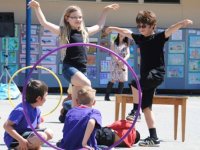Classroom Connections: Arts Integration Up Close
Your content has been saved!
Go to My Saved Content.Once again, 450 elementary students in San Rafael, Calif., turned their classroom lessons into a school-wide celebration of learning in the first-ever Classroom Connections Festival. Students performed dances, made music, and displayed works of art that were aligned with their grade-level curriculum, exploring subjects from animal behavior and math facts to American history and electromagnetism.
Classroom Connections is an integrated learning program designed to cultivate a "community" approach to teaching and learning. Together, classroom teachers and music, art, and dance instructors spent half the school year providing children with multiple modes of instruction across multiple disciplines.
The goal of Classroom Connections is to deepen learning and allow students to use their knowledge in creative ways and is based on Harvard's "Teaching for Understanding" model of arts integration. The Classroom Connections Festival was not just an art and music exhibition, it was an exhibition of understanding.
How It Works
This was a school-wide effort where teachers collaborated with arts specialists to explore shared concepts and parallel processes. Teachers worked together to find learning opportunities that leverage cross-disciplinary connections. The art teacher/classroom teachers crafted a "Guiding Question" that was explored by both the art teacher and the classroom teacher throughout the unit. The culmination of the unit was a "Performance of Understanding" at the Classroom Connections Festival.
Classroom Connections was inspired by two amazing programs from the San Francisco bay area:
Summer is a great time to start planning a Classroom Connections Festival! The payoff can be great. The principal of the elementary school, Julie Harris, explained how the project motivates her students, "Children learn in many ways, and the more modes they use, the better they are understanding. By folding their classroom instruction together with music, movement, and visual arts, our kids are firing on all cylinders!"
- Teaching for Understanding: "What topics are worth understanding? What about these topics needs to be understood? How can we foster understanding? How can we tell what students understand?"
- Studio Habits of Mind: Eight specific dispositions that are used in artists' studios, many academic areas and in daily life. Thinking about Studio Habits helps identify connections that help transfer information from one discipline to another.
- Music Plus Music Integrated (M+MI): Teaching and learning that is mutually reinforcing across disciplines.
- Musical Habits of Mind: Five specific dispositions that are used by musicians and in daily life identify connections that help transfer information from music to other disciplines; Listen, Question, Create, Reflect and Perform

